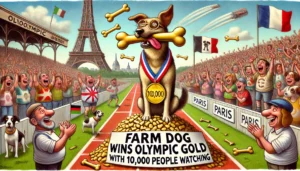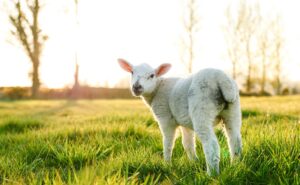
FarmerCowboy.com A humorous illustration of a farmer sitting in a barn scrolling through Pinterest on a tablet while surrounded by farm tools and animals. The farmer.webp.webp
Shocking Study Reveals Farmers Now Spend Half Their Day on Pinterest Hunting for DIY Farm Hacks!
“From Chicken Coops to Tractor Mods, Farmers Are Pinning Their Way to Success—But Is It Helping or Hurting?”
Rural Route, Nebraska – In a surprising new study that has shocked traditionalists and delighted DIY enthusiasts, researchers have found that farmers now spend a staggering 50% of their day on Pinterest, searching for farm hacks, DIY projects, and creative solutions to everyday farming challenges. The study, conducted by the Institute of Agricultural Innovations (IAI), reveals that the modern farmer is as likely to be found pinning a chicken coop design as plowing a field.
The findings have raised eyebrows across rural America, where Pinterest was once thought of as the domain of urban crafters and home decorators. But it seems that the platform’s endless supply of DIY inspiration has made it a go-to resource for farmers looking to streamline their operations—or just add a little flair to the farm.
The Pinterest Craze
According to the study, farmers are flocking to Pinterest in droves, seeking out everything from sustainable farming tips to crafty ways to upcycle old tractor parts. For many, the platform has become an essential tool in their daily routine, offering innovative ideas that range from the practical to the downright quirky.
Take Farmer Bob “Pinmaster” Jenkins, for example. Bob, who runs a small dairy farm just outside of Rural Route, admits that he spends more time on Pinterest than he does in the barn. “I’ve found some amazing hacks on there,” he said, proudly showing off his DIY automatic cow milker made from repurposed PVC pipes and duct tape. “Who needs fancy equipment when you’ve got Pinterest?”
Public Opinion: Mixed Reactions
The study’s findings have sparked a lively debate in the farming community. Some farmers see Pinterest as a valuable resource, while others view it as a distraction from the real work of farming.
“I think it’s great,” said Betty Lou “Boarder” McCoy, who runs a successful chicken farm. “I’ve learned how to build better coops, create my own feed, and even make adorable little chicken sweaters for the winter—all thanks to Pinterest!”
But not everyone is convinced. “Farmers these days spend too much time on their phones and not enough time in the fields,” grumbled Old Man “Plow” Perkins, a retired farmer with over 50 years of experience. “Back in my day, we didn’t need Pinterest—we just figured things out with hard work and a bit of common sense!”

The Pinterest Effect
For many farmers, Pinterest has become more than just a source of inspiration—it’s a way of life. The platform’s endless stream of ideas has led to a new breed of farmer who is as skilled with a glue gun as they are with a plow.
“Pinterest has revolutionized the way I farm,” said Sarah “Crafty” Wheeler, who runs an organic vegetable farm. “I’ve found ways to make my operation more efficient, more sustainable, and a lot more fun. Plus, I get to share my own ideas with other farmers around the world!”
Sarah’s Pinterest board is a treasure trove of creative projects, from homemade scarecrows to eco-friendly irrigation systems. “It’s amazing how much you can do with a little creativity and some elbow grease,” she said, pinning a new project for a vertical garden made from old pallets.
The Downsides of Pinterest Farming
But while Pinterest has its fans, not everyone is sold on the idea of farmers spending half their day scrolling through DIY projects. Critics argue that the platform can be a time sink, leading farmers to focus more on aesthetics than actual productivity.
“I’ve seen some ridiculous things on Pinterest,” said Jerry “Straight Shooter” Moosington, a corn farmer who prides himself on his no-nonsense approach to farming. “People making hay bale couches, painting their barns in polka dots—it’s all well and good, but at the end of the day, it doesn’t put food on the table.”
Jerry worries that the Pinterest craze is taking farmers away from the important work of growing crops and raising livestock. “There’s a reason we’ve done things the same way for generations,” he said. “It works. All this Pinterest nonsense is just a distraction.”
Pinterest Success Stories
Despite the criticism, many farmers swear by Pinterest and credit the platform with helping them find success in an increasingly challenging industry. Take Farmer Tom “Pinspired” Johnson, for example, who turned his struggling apple orchard into a thriving business by using Pinterest to market his products.
“I started pinning recipes, craft ideas, and even photos of my apple trees,” Tom explained. “People loved it. Before I knew it, I had customers driving in from all over the state just to see my orchard and buy my apples. Pinterest saved my farm.”
Tom’s story is just one of many. Across the country, farmers are using Pinterest to not only improve their operations but also connect with customers and build their brands. “It’s like having a free marketing department,” Tom said. “And the best part is, it’s actually fun.”

Pinterest vs. Tradition
The rise of Pinterest farming has sparked a debate between traditionalists and modernists. On one side are the old-school farmers who believe in sticking to tried-and-true methods. On the other side are the Pinterest-savvy farmers who embrace innovation and creativity.
“I get it—tradition is important,” said Sarah Wheeler. “But times are changing, and we have to change with them. Pinterest gives us the tools to be more efficient, more sustainable, and more connected to our customers. Why wouldn’t we take advantage of that?”
Old Man Perkins, however, remains unconvinced. “Pinterest is just a fad,” he said. “Real farming is about hard work, not pinning pictures of chicken coops and scarecrows. Let’s see how many of these Pinterest farmers are still around in ten years.”
The Future of Pinterest Farming
Whether you love it or hate it, one thing is clear: Pinterest is here to stay. As more farmers turn to the platform for inspiration and ideas, it’s likely that we’ll see even more creative solutions to everyday farming challenges.
“I can’t wait to see what’s next,” said Betty Lou McCoy. “Pinterest has opened up a whole new world of possibilities for farmers like me. The sky’s the limit!”
Insider Tips for Farmers & Cowboy Readers
If you’re a farmer looking to make the most of your time on Pinterest, here are some insider tips to help you get started:
- Step-by-Step Guides: Create dedicated Pinterest boards for different aspects of your farm, from animal care to crop management. This will help you stay organized and find the ideas you need quickly.
- Pro Tips: Don’t just pin ideas—make sure to follow through and try them out. You’ll be surprised at how many Pinterest hacks actually work!
- Insider Knowledge: Engage with other farmers on Pinterest by commenting on their pins and sharing your own experiences. The farming community on Pinterest is a great resource for advice and support.
- Best Practices: Be selective about what you pin. It’s easy to get overwhelmed by the sheer volume of ideas on Pinterest, so focus on projects that are practical and achievable for your farm.
- How-to Tutorials: If you’re new to Pinterest, start by searching for specific topics like “DIY farm hacks” or “sustainable farming.” This will help you find relevant ideas without getting lost in the Pinterest rabbit hole.
Cautionary Disclaimer
Warning: This article is a work of satire and should not be taken as real advice. While Pinterest can be a valuable resource for inspiration, spending half your day on the platform may not be the most productive use of your time. Farmercowboy.com is not responsible for any failed DIY projects, excessive pinning, or barn makeovers that result from reading this article.
15 Humorous Observations with Wordplay and Witty Puns:
- Forget plowing fields—farmers are now plowing through Pinterest boards!
- Who knew farming involved so much scrolling and pinning?
- Farmers’ thumbs are getting more workout from scrolling Pinterest than planting crops!
- The new crop rotation: corn, wheat, and endless DIY projects.
- Pinterest has become the ultimate tool for sowing seeds of creativity on the farm!
- “Pin-teresting” developments: Farmers are trading in their pitchforks for Pinterest accounts.
- Who needs a tractor manual when you have a Pinterest board full of hacks?
- The only thing growing faster than crops is farmers’ DIY project lists.
- Pinterest: Where farmers discover that pallets aren’t just for stacking, they’re for crafting too!
- From barn décor to hay bale art, Pinterest has turned farmers into DIY divas.
- The only thing more satisfying than a good harvest is a perfectly executed Pinterest project!
- These days, the sound of a tractor is second only to the click of a Pinterest pin.
- Who knew farming success could be measured by repins and likes?
- Farmers now spend half their time farming and the other half perfecting their Pinterest-worthy chicken coops.
- Pinterest has replaced almanacs as the go-to guide for farm innovation!

Originally posted 2021-09-22 22:20:04.
Originally Published at FarmerCowboy.com
2025-05-09 20:28:53
Karl Hoffman is a distinguished agriculturalist with over four decades of experience in sustainable farming practices. He holds a Ph.D. in Agronomy from Cornell University and has made significant contributions as a professor at Iowa State University. Hoffman’s groundbreaking research on integrated pest management and soil health has revolutionized modern agriculture. As a respected farm journalist, his column “Field Notes with Karl Hoffman” and his blog “The Modern Farmer” provide insightful, practical advice to a global audience. Hoffman’s work with the USDA and the United Nations FAO has enhanced food security worldwide. His awards include the USDA’s Distinguished Service Award and the World Food Prize, reflecting his profound impact on agriculture and sustainability.



